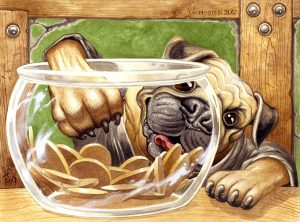
Last time I talked a bit about Fortune, and why it’s written the way it is. Now I want to get into two questions I get a lot: How often to award Fortune, and why Fortune in Mau works differently.
One thing that’s implicit in Fortune but never spelled out is that it’s inverse to dramatic tension. When the tension of the story is low, in general players are generating Fortune, and when the tension is high, players are generally spending it. So the first half of the adventure, Fortune should be going up, but in the second half it’s going back down. Since Fortune resets at the end of the adventure, the ideal path is spending down to zero right near the end.
As a Guide, that’s a good metric. If players are generally coasting in the first half, encourage them to make things more complicated. Suggest botching rolls, and remind them of their personality traits. Sometimes, I give Fortune out early on for a great joke or a wonderful roleplay scene, just to remind them that it’s out there. The reasons a Guide can give Fortune are intentionally vague for that reason. In general, it’s not going to hurt anything if you err on the side of giving Fortune for the first half.
As things get tougher, hit the players hard. Enemies are, on average, a bit tougher than their D&D counterparts, and that’s intentional. If characters work together and squeeze every resource our of their tricks and items, they can generally just about defeat an equivalent enemy. Fortune makes that easier, and gives players room to take character-appropriate actions over game-efficient actions. But it’s not a guarantee — you can spend Fortune and still fail — so definitely encourage them to spend it as well as acquire it.
One rule that doesn’t get a lot of play is letting non-player characters spend Fortune into the bowl. If you want an enemy to take a decisive action, put a Fortune in the bowl and let them interrupt initiative. This is great because players sometimes get into the flow of organizing their rounds, but in a big fight having an enemy take control is a shock. Plus, it can add a Fortune to their bowl if it’s out, so players don’t feel too bad when it happens.
Okay, that’s pacing. Why do cats have the option to keep Fortune? The objective answer is that I wanted to add a level of player-vs-player tension in Monarchies of Mau. It’s a more explicitly political game than Pugmire (there are politics in Pugmire, but they’re generally in the background). By allowing players to keep their own resources that they cannot share, cats have the option to create their own luck, which is very much a theme of the game. But here’s the big secret.
Mau players rarely use that option.
Once you put a bit pot of points in the middle of the table and say that everyone can share, players rarely want to be the person to decide that they’re not going to share. I’ve never seen a cat player use that option more than once in a game, and usually on the level of a “just in case” measure. Having one point in reserve feels great when everything’s down to you, the dice have been evil, and the Fortune bowl is dry. But in truth, it’s a bigger risk to the group to horde the point than to let it go to the bowl.
So why offer it at all? Because having the option is a big part of the game. Cats CAN be selfish jerks. Dogs don’t even get the option, but cats do. (And pirates will have another option as well.) Having the option changes the dynamic, in the same way as destroying relics changes the relationship with magic items.
Hrm, I should do a blog about that as well at some point.

I love these posts. I have been reading Monarchies of Mau in preparation for running my first game and this type of clarification really helps me allot. Thank you very much!